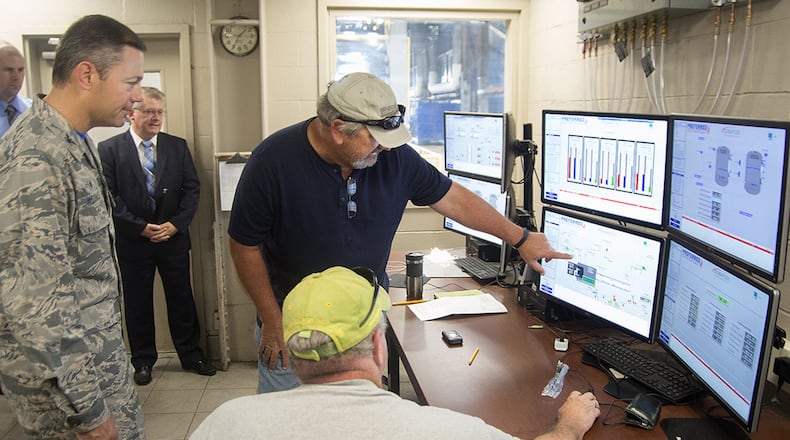The Area A heat plant boiler conversion project is a testament to these realized benefits.
Wright-Patterson Air Force Base faced the task of bringing two of its central heating plants into compliance with the new maximum achievable control technology emission limits for boilers established by the U.S. Environmental Protection Agency. The project eliminated coal-burning boiler components used to produce heat for most buildings throughout Area A and replaced them with natural gas components.
“Because of successful energy-conservation measures and the recent decentralization of WPAFB’s heating systems, project managers decided to convert just two coal-burning boilers and eliminate two other coal-burning boilers,” said Ken Ferguson, 88th Civil Engineer Group heat plant supervisor.
The project installed modern gas burners capable of 10:1 turndown (100 percent to 10 percent capacity), providing sufficient operating range to accommodate load carrying and standby modes.
“Firing such burners in this manner simplifies burner-management systems, fuel -safety piping, and associated controls, keeping overall project costs in check while maximizing energy efficiency,” said Randy Brown, 88th Civil Engineer Group design manager.
In addition to project savings and energy efficiency, the conversion project realized significant environmentally mandated benefits.
The original heat plant boilers were manufactured in 1979 and state-of-the-art design initiatives and up-to-date environmental mandates did not exist. Newly established EPA guidance specified the units were limited by emissions permit. Emissions control the amount of air pollutants allowable, and the EPA has regulatory and voluntary programs in place to reduce the amount of air pollutants emitted from a wide range of emission sources. This project reduced various residual air pollutants, such as nitrogen oxide emissions and sulfur dioxide emissions by 65 tons and 225 tons per year, respectively.
While the upgrades were focused on reducing emission of specific pollutants, an equally notable result was the fact greenhouse gas (GHG) carbon dioxide emissions were reduced as a result of converting from coal to natural gas.
According to Emily Erdei, 88th Civil Engineer Group environmental specialist, “Comparing baseline years (our first GHG reporting year) and a rolling total of gas used at the plant between 2016-2017, GHG emissions have lowered by 24,800 metric tons.”
Additional energy reductions were also realized through various energy savings measures. The overall heat plant output was reduced to 80 MMBtu or million British thermal units. This equates to an overall 20 percent energy reduction. In addition, all mechanical controls were updated and replaced, making it easier for troubleshooting and maintenance saving plant operator’s time. This is one example where concerted reduction efforts pay dividends from an environmental compliance and energy reduction standpoint.
Dedicated Wright-Patterson members are critical to both further identifying opportunities associated with energy reduction and doing their part on a daily basis to reduce our energy footprint.
“The continuing energy reduction efforts of every WPAFB Airman allows world-class research and development and other critical Air Force missions to be sustained in an era of continuing funding restrictions,” said Col. Bradley McDonald, 88th Air Base Wing commander.
These programs, among others, mark WPAFB’s commitment to proper energy stewardship reminding everyone they play a critical role in preserving our critical resources. This is the powerful message behind this year’s EAM master slogan, “Protect the Power” serving as a call to every Airman to protect critical power resources and do their part to conserve energy.
October’s Energy Action Month will focus on providing an opportunity for Airmen to learn more about the impact of energy to the Air Force’s mission. Protecting the power involves all Airmen doing their part to conserve energy where possible and encourages everyone to share best practices and innovative ideas.
“Our energy team is excited about Energy Action Month and has numerous activities planned for all base personnel,” said Mike Tibbs, 88th Civil Engineer Group Energy management chief.
Activities during the month include weekly energy displays (highlighted below), training, videos, fact sheets and articles distributed via the Air Force website, and dozens of others.
Weekly energy displays for WPAFB include:
• Headquarters Air Force Materiel Command, Oct. 4, 11 a.m.-1 p.m.;
• National Air & Space Intelligence Center, Oct. 11, 11 a.m.-1 p.m.;
• 711 Human Performance Wing, Oct. 18, 11 a.m.-1 p.m.;
• Bldg. 16, Area B, Oct. 25, 11 a.m.-1 p.m.
WPAFB continues to abide by energy conservation presidential mandates, “green” initiatives, the Office of the Secretary of Defense mandates and Air Force senior leadership benchmarks. The goal is not only to achieve but to exceed these goals without causing significant discomfort or inconvenience for Team Wright-Patt members or impacting missions.
To learn more about energy initiatives or to submit any energy-related questions or ideas, contact the 88th CEG Energy Office at WPAFBEnergyOffice@us.af.mil. Additionally, visit the energy management site at https://cs2.eis.af.mil/sites/21020/wpafb/cen/cenp/cenpe/energyaware/default.aspx for further energy initiatives and additional information.
About the Author
